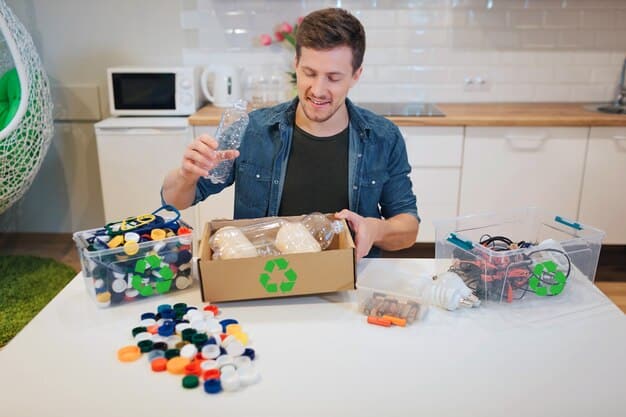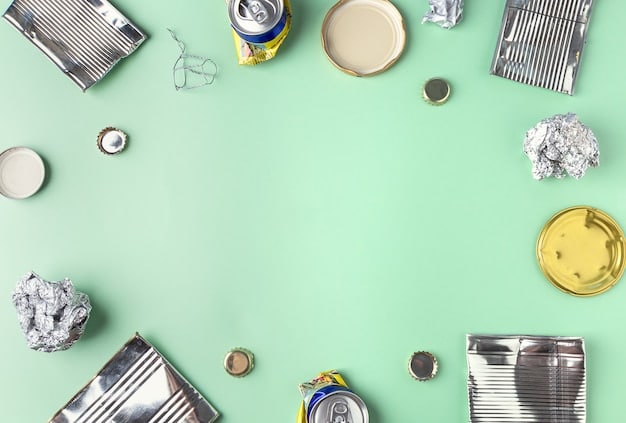Reduce, Reuse, Recycle: Cut Landfill Waste by 40% with Our Guide

Achieving a 40% reduction in landfill waste is attainable through the consistent application of the “Reduce, Reuse, Recycle” principles, focusing on conscious consumption, extending product lifecycles, and diligent material sorting at home.
In a world grappling with mounting waste, the imperative to adopt sustainable practices has never been clearer. This guide explores how embracing the principles of Reduce, Reuse, Recycle: Cut Your Landfill Waste by 40% with This Comprehensive Guide offers a tangible path towards significantly lowering your environmental impact, transforming daily habits into powerful actions for a healthier planet.
Understanding the Waste Crisis and Its Impact
The sheer volume of waste generated globally presents a pressing ecological and social challenge. From overflowing landfills to ocean pollution, the consequences of our consumption patterns are far-reaching, affecting ecosystems, public health, and even climate stability. Understanding the scale of this crisis is the first step toward effective change.
Our current linear economic model—take, make, dispose—is inherently unsustainable. This model encourages rapid resource depletion and massive waste generation. Landfills release methane, a potent greenhouse gas, while incinerators contribute to air pollution. The challenge lies in shifting towards a more circular economy where resources are valued, conserved, and reused.
The Environmental Toll of Landfills
Landfills are not just unsightly; they are environmental hazards. They leach toxic substances into soil and groundwater, contaminating vital natural resources. The decomposition of organic waste in landfills produces methane, a greenhouse gas that is far more potent than carbon dioxide in the short term, significantly contributing to global warming.
- Groundwater Contamination: Leachate, a toxic liquid formed when water filters through waste, can seep into drinking water sources.
- Air Pollution: Beyond methane, landfills emit various volatile organic compounds (VOCs) and other hazardous air pollutants.
- Habitat Destruction: Large tracts of land are cleared for new landfills, destroying natural habitats and biodiversity.
Economic and Social Implications
Beyond the environmental damage, waste management carries significant economic costs. Municipalities spend billions annually on waste collection, transportation, and disposal. These costs are often passed on to taxpayers. Moreover, waste disproportionately affects marginalized communities, who often live near landfills and suffer greater health impacts.
Transforming our waste habits is not just about environmental protection; it’s about fostering more resilient communities and sustainable economies. By reducing waste, we lessen the financial burden on public services and create opportunities for new green industries, such as recycling and repair services, which can generate jobs and economic growth.
The “Reduce” Principle: Minimizing Consumption
The most impactful step in waste management is preventing waste from being created in the first place. This is the essence of “Reduce.” It calls for a fundamental shift in our consumption habits, moving away from impulse buying and disposability towards intentional choices. Every item not purchased is an item that doesn’t need to be produced, transported, consumed, or eventually disposed of.
This principle emphasizes that our purchasing decisions have a ripple effect across the entire supply chain. By simply buying less, or buying products designed for longevity and minimal packaging, we can significantly decrease our footprint. It’s about questioning the necessity of a purchase and prioritizing quality over quantity.
Conscious Consumerism and Mindful Purchasing
Adopting conscious consumerism means thinking critically about what we buy, why we buy it, and its entire lifecycle. It involves researching brands, understanding supply chains, and supporting companies committed to sustainable practices. This shift in mindset can lead to profound impacts on personal waste generation.
When shopping, consider these questions:
- Is this item truly necessary? Often, we buy things out of habit or marketing influence rather than actual need.
- What is this product made from? Opt for durable, sustainably sourced, and recyclable materials.
- How is it packaged? Choose items with minimal, recyclable, or compostable packaging, or buy in bulk.
Avoiding Single-Use Items
Single-use plastics and disposables are major contributors to landfill waste. From coffee cups to plastic cutlery, these items are used for mere minutes but persist in the environment for centuries. Making a conscious effort to refuse these items and opt for reusable alternatives is a simple yet powerful act of reduction.
Practical steps include carrying a reusable water bottle, coffee cup, shopping bags, and even portable cutlery. These small adjustments can dramatically cut down on daily waste. Many businesses now offer incentives for using reusable containers, making these habits not just eco-friendly but also economically beneficial.
The “Reuse” Principle: Extending Product Lifecycles
Once items enter our possession, the “Reuse” principle encourages us to keep them in circulation for as long as possible. This means repairing broken items, finding new purposes for old things, and prioritizing second-hand purchases. Every item reused means one less new item needs to be produced, conserving resources and energy.
Reusing is a creative and often cost-effective approach to waste reduction. It challenges us to look beyond a product’s initial function and consider its potential for a second life. This principle fosters resourcefulness and can even lead to unique personal expressions through upcycling and repurposing.
Repair, Refurbish, and Regain
Before discarding a broken item, consider whether it can be repaired. Repairing electronics, clothing, and appliances not only saves money but also significantly extends their lifespan, preventing them from ending up in landfills. Many communities have “repair cafés” or local artisans who can help.
Refurbishing old furniture or appliances also falls under this category. A fresh coat of paint or a minor fix can transform an outdated item into something new and functional, diverting it from the waste stream. This practice also supports local economies and craftsmanship.

Donating and Second-Hand Shopping
Donating usable items to charities or thrift stores ensures they find a new home rather than being discarded. This extends their useful life and often supports social causes. Similarly, embracing second-hand shopping for clothing, furniture, and electronics reduces demand for new products and saves resources.
The market for pre-owned goods has expanded rapidly with online platforms and consignment stores. Buying second-hand is not only environmentally responsible but often more economical. It promotes a circular economy where products are continuously used and valued.
The “Recycle” Principle: Transforming Waste into Resources
When reduction and reuse are not possible, recycling steps in as the next best option. Recycling involves processing used materials into new products, diverting them from landfills and conserving natural resources. It closes the loop in the consumption cycle, transforming what was once considered waste into valuable raw materials.
Effective recycling depends on knowing what can be recycled in your local area and how to prepare materials correctly. Contamination is a major issue in recycling, making it crucial to understand the specific guidelines provided by your municipal waste management or private recycling facility.
Understanding Local Recycling Guidelines
Recycling rules vary significantly by location due to differences in collection systems, processing technologies, and market demands for recycled materials. “Wishcycling”—the act of placing items in the recycling bin hoping they can be recycled—often does more harm than good by contaminating entire batches.
Before recycling, take time to understand your local program’s specifics.
- Check accepted materials: Not all plastics, glass, or metals are universally recyclable.
- Clean and sort: Rinse food containers; remove lids or labels if required.
- Know your numbers: Plastic items often have a recycling symbol with a number; understand which numbers your facility accepts.
The Challenges and Benefits of Recycling
While recycling is crucial, it’s not without its challenges. Market fluctuations for recycled commodities, high processing costs, and consumer confusion about what is recyclable are common hurdles. Despite these, the benefits are substantial.
Benefits of recycling include:
- Resource Conservation: Less need to extract virgin raw materials, preserving natural habitats.
- Energy Savings: Producing goods from recycled materials often requires less energy than from virgin materials.
- Reduced Pollution: Lower emissions from manufacturing and reduced landfill waste.
- Economic Opportunities: The recycling industry creates jobs and economic value.
It is important to remember that recycling is the last resort in the waste hierarchy, following reduce and reuse. Its effectiveness is maximized when combined with the other two principles.
Composting: Diverting Organic Waste
Organic waste, such as food scraps and yard trimmings, constitutes a significant portion of what ends up in landfills. When organic matter decomposes in oxygen-deprived conditions within a landfill, it produces methane, a potent greenhouse gas. Composting offers a powerful solution to divert this waste, transforming it into a nutrient-rich soil amendment.
Composting is an aerobic process where microorganisms break down organic materials into humus, a dark, rich substance that enhances soil health. By composting, you not only reduce landfill burden but also improve your garden soil, reduce the need for chemical fertilizers, and close the nutrient loop in your home or community.
Home Composting Methods
There are several methods for composting at home, ranging from simple piles to sophisticated bins, suitable for various living situations.
- Backyard Composting: Ideal for those with a garden, this involves a simple pile or a designated bin for kitchen scraps and yard waste. It’s low-cost and produces a good volume of compost.
- Vermicomposting (Worm Composting): Using special worms (red wigglers) in a contained bin, this method is great for smaller spaces or apartments, as it produces less odor and quickly breaks down food scraps.
- Bokashi Composting: An anaerobic fermentation method that uses a special bran to “pickle” food waste, including meat and dairy, before it’s buried or added to a compost pile.
The Benefits of Composting
Beyond reducing landfill waste and methane emissions, composting provides numerous benefits for both the environment and your local ecosystem.
Benefits include:
- Soil Enrichment: Compost adds organic matter to soil, improving its structure, water retention, and nutrient content, leading to healthier plants.
- Reduced Chemical Use: Rich, healthy soil lessens the reliance on synthetic fertilizers and pesticides.
- Water Conservation: Improved soil structure allows soil to hold more water, reducing irrigation needs.
- Local Food Production: Composting supports growing food at home, reducing reliance on long-distance transportation.
The 40% Reduction Goal: Practical Steps and Strategies
Achieving a 40% reduction in landfill waste is an ambitious yet entirely attainable goal for individuals and households. It requires a combination of conscious decisions, consistent effort, and a systematic approach to waste management. This goal is not just about environmental responsibility; it’s about fostering a more mindful and resource-efficient lifestyle.
Breaking down the goal into manageable steps makes it less daunting. Start small, implement changes gradually, and celebrate your successes. The cumulative effect of many small changes can lead to significant overall impact, demonstrating that individual actions collectively create powerful change.
Conducting a Home Waste Audit
Before you can cut your waste, you need to know what kind of waste you are generating. A simple home waste audit over a week can provide invaluable insights. Collect and categorize your trash, noticing patterns and identifying the biggest contributors to your waste stream. This data will help you target your efforts effectively.
Common waste audit findings often include:
- Food Waste: A large percentage of household waste is edible food that goes bad.
- Single-Use Items: Packaging, plastic bottles, and disposable coffee cups often accumulate quickly.
- Textiles: Old clothing and fabrics also contribute significantly to landfills.
Once you know your “waste hotspots,” you can tailor your reduce, reuse, and recycle strategies to address them directly.

Strategizing for a 40% Reduction
With an understanding of your waste profile, you can implement targeted strategies. Focus on incremental improvements across all three R’s.
- Food Waste Reduction: Plan meals, use leftovers creatively, store food properly to extend freshness, and compost unavoidable scraps.
- Shopping Habits: Carry reusable bags, buy in bulk, choose products with minimal packaging, and prioritize durable, long-lasting items.
- Home Organization: Declutter regularly and donate, sell, or repair items instead of discarding them. Create clear systems for recycling and composting in your home.
- DIY Solutions: Make your own cleaning products, personal care items, or even simple snacks to cut down on packaged goods.
Remember that consistency is key. Even if a 40% reduction seems challenging initially, every small improvement contributes to the larger goal. Engage your family members in the process, making it a collective effort.
Overcoming Challenges and Sustaining Efforts
The journey toward a zero-waste or significantly reduced-waste lifestyle is rarely without its challenges. Convenience, societal norms, and a lack of infrastructure can pose hurdles. However, with perseverance, creative problem-solving, and a focus on long-term benefits, these obstacles can be overcome, leading to sustainable habits.
It’s crucial to acknowledge that perfection is not the goal; continuous improvement is. There will be times when you generate more waste than intended, or when sustainable options are not readily available. The key is to learn from these instances and recommit to your goals.
Addressing Common Barriers
One common barrier is the perceived inconvenience of sustainable choices. For instance, remembering reusable bags or a coffee cup requires a shift in routine. Another challenge is the lack of proper recycling facilities for certain items, or the absence of robust composting programs in some areas.
To overcome these:
- Plan Ahead: Keep reusable items by the door or in your car so they are always ready.
- Advocate for Change: If local infrastructure is lacking, join or support local advocacy groups pushing for better waste management.
- Educate Yourself: Stay informed about new sustainable products and methods.
Many challenges can be met with small, mindful adjustments rather than drastic overhauls.
Building a Sustainable Lifestyle
Reducing landfill waste by a significant margin is not a temporary project; it’s about establishing a sustainable lifestyle. This involves integrating conscious consumption, resourcefulness, and responsible disposal into your daily routine.
Consider these aspects for long-term integration:
- Community Engagement: Connect with local groups, attend workshops, and share tips with neighbors. Collective action amplifies individual efforts.
- Continuous Learning: The field of sustainable living is constantly evolving. Stay curious and open to new ideas and methods.
- Patience and Persistence: Changing long-ingrained habits takes time. Be patient with yourself and celebrate small victories along the way.
Ultimately, a sustainable lifestyle is one that benefits not just our planet but also our well-being, fostering a deeper connection to the resources we consume and the impact we make.
Future Trends in Waste Management
The landscape of waste management is continually evolving, driven by innovation, policy changes, and growing societal awareness. Looking ahead, several promising trends are emerging that could further accelerate our efforts to reduce landfill waste and move closer to a truly circular economy. These advancements promise more efficient processes, new material developments, and greater integration of waste into beneficial uses.
Keeping abreast of these developments can offer insights into the future of sustainable living and inspire further participation in waste reduction efforts. From advanced recycling technologies to greater emphasis on design for circularity, the horizon holds exciting possibilities.
Advanced Recycling Technologies
Traditional mechanical recycling has limitations, particularly for mixed plastics and complex materials. However, advanced recycling technologies are emerging that can break down plastics into their chemical components, allowing them to be rebuilt into new, high-quality products.
Examples include:
- Chemical Recycling: Processes like pyrolysis and gasification can convert mixed plastic waste into oils or gases that serve as feedstock for new plastics.
- Textile-to-Textile Recycling: Innovations in breaking down old fabrics (both natural and synthetic) to create new yarn and clothing.
- Organic Waste-to-Energy: Technologies that convert organic waste into biogas or other forms of renewable energy.
These technologies hold the potential to unlock new value from waste streams that were previously difficult to recycle.
The Circular Economy and Design for Disassembly
The broader concept of the circular economy is gaining significant traction. Unlike the linear “take-make-dispose” model, a circular economy aims to keep resources in use for as long as possible, extract the maximum value from them whilst in use, then recover and regenerate products and materials at the end of each service life.
Key elements include:
- Product-as-a-Service Models: Companies retaining ownership of products and leasing them to customers, incentivizing durability and easy repair.
- Design for Disassembly: Products engineered from the outset to be easily taken apart and their components reused or recycled.
- Biomaterials and Biodegradables: The development of new materials that can safely return to the biosphere after use, minimizing persistent waste.
These trends signify a systemic shift where waste is viewed not as an end point but as a valuable input for new cycles of production and consumption, moving us closer to a future where landfill waste becomes an anomaly rather than a norm.
| Key Action | Brief Description |
|---|---|
| 🛒 Reduce Consumption | Buy less, choose items with minimal packaging, and prioritize need over want. |
| ♻️ Reuse & Repair | Extend product lifecycles by repairing, donating, and opting for second-hand purchases. |
| 🌳 Compost Organics | Transform food scraps and yard waste into nutrient-rich soil, diverting methane-producing landfill material. |
| 📊 Audit Your Waste | Regularly assess your trash to identify waste hotspots and tailor reduction strategies. |
Frequently Asked Questions About Waste Reduction
▼
Beyond reducing landfill volume, waste reduction conserves natural resources, minimizes pollution from extraction and manufacturing, and lessens energy consumption. It also cuts greenhouse gas emissions, mitigating climate change, and protects ecosystems from the adverse impacts of resource exploitation and pollution.
▼
Starting with single-use items is often easiest. Focus on reusable shopping bags, water bottles, coffee cups, and food containers. For reuse, consider donating old clothes or electronics instead of discarding them. These small, consistent changes significantly decrease daily waste generation.
▼
Generally, yes, recycling is better than landfilling, as it conserves resources and reduces pollution. However, the energy and resources required for recycling vary. It’s crucial to prioritize reduce and reuse first. Only recycle items that are clean and accepted by your local facility to avoid contamination.
▼
Absolutely. Many households successfully achieve and even exceed a 40% reduction by diligently applying the principles of reduce, reuse, and recycle. The most significant impact often comes from reducing consumption and composting organic waste, rather than solely relying on recycling, which has limits.
▼
Governments can implement policies like extended producer responsibility, bans on single-use plastics, and enhanced recycling infrastructure. Businesses can embrace circular design, offer “product-as-a-service” models, and invest in sustainable packaging. Their actions are crucial for systemic change alongside individual efforts.
Conclusion
The journey to significantly reduce landfill waste is a collective endeavor, beginning with individual commitment. By systematically embracing the principles of reduce, reuse, and recycle, coupled with diligent composting, households can indeed make substantial strides towards the ambitious goal of cutting their landfill contribution by 40% or more. This comprehensive approach not only mitigates environmental degradation but also fosters a more mindful relationship with our resources, paving the way for a more sustainable and resilient future for all. Each conscious choice, no matter how small, contributes to the monumental shift required to move from a linear economy of waste to a regenerative one of value.





